Contents
- TA details
- Homepage
- Magazine index
- Our history
- Contact details
- Subscription
- Discovery procedure
- Meeting reports
- Youtube channel
- Members' services
- E-circular archive
- On-line charts
- Sales
- Chart catalogue
- Special publications
- Back issues
- Videos
- Advertising rates
- Observations
- Aurora/NLC
- Comets
- Deep sky
- Eclipses/Transits
- Gamma Ray Bursts
- Meteors
- Minor planets
- Planets
- Sun
- Supernovae
- TNOs
- Novae/Variables
- Links
- Vizie-R
- JPL Horizons
- IAU Central Bureau
- Minor Planet Center
- Heavens Above
- BAA
- Further links
|
|
The eclipse of 1998 February 26 was widely seen around the Caribbean and
there are many good sources of pictures and reports on the web including:
The images which appear on this page are taken from a video made
by Nick James. He was situated on a beach on the northeast coast of the
Peninsula de Paraguana in Venezuela. The video was taken using a Sony
TR-3100 Hi-8 camcorder. Various clips from this tape are available in
RealMedia format.
Click on the small images to download full-sized JPEG pictures.
|
On eclipse morning we left Caracas at 2 a.m. in order to catch a charter
flight to Punto Fijo. From there we drove to Coro for breakfast and then back
on to the Peninsula de Paraguana. We arrived at the observing site at about
11 a.m. and had plenty of time to set up and check our equipment.
When we arrived the sky had clouded over completely. This was not good news!
As the partial phase started the sky began to clear and by the time John
Mason did a piece to camera the sky was cloud-free. The head-gear is an
important part of eclipse tradition and there is some evidence that the hat
did scare the clouds away.
|

John Mason's lucky hat
|
|
John had brought along a light meter calibrated in lux (lumens/m^2) which was
more used to measuring the output of streetlights in Basingstoke. He would
use this closer to totality in order to determine the
light levels during the eclipse.
This data should prove useful when predicting what time the
streetlights will come on in Cornwall during the next eclipse!
After a long partial phase the last glimmers of the sun began to
die away and the light level fell below 100 lux. At this time dramatic
shadow-bands appeared on the beach. The shadow-bands were an extraordinary
sight since they were very dynamic and very distinct. John Mason was the
first to yell "shadow bands" since he was looking down at his light meter.
|
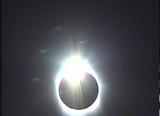
18:09:12 UTC
|
|
With the Sun now completely covered the pearly Corona was clearly visible.
Light levels had dropped to 3 lux but the shouts and screams from the assembled
group of observers would not diminish for many minutes. The Corona showed a
characteristically boxy form and an amazing amount of detail was visible in
binoculars.
A large red prominence was visible at about 12 o'clock and this added to the
awesome beauty of the event.
|
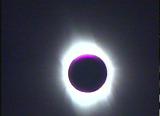
18:09:26 UTC
|
|
One of the advantages of the TR-3100 is that the user has full control of the
exposure and aperture settings in a way that is similar to an SLR still
camera. This allowed
me to reduce the exposure to show detail in the inner corona and the
prominences.
|
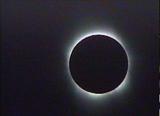
18:09:58 UTC
|
|
Three planets were easily visible during the eclipse. Jupiter and Mercury were
near to the Sun and are visible in this frame. The camera was set to a long
exposure (1/3 sec) and zoomed out. The sky is still blue even during totality!
Much further from the Sun was Venus and this planet was visible for a full
five minutes before the start of totality.
I didn't see any other objects during the eclipse but I must admit that I
wasn't looking too hard!
|
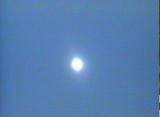
18:10:34 UTC
|
|
At about 40 seconds before the end of the eclipse an impressive prominence
appeared at the 6 o'clock position and the light level rose to 9 lux. Another
prominence-like feature was seen at 4 o'clock.
|
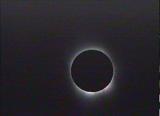
18:12:31 UTC
|
|
With a few seconds to go the bright red Chromosphere appeared at the 5 o'clock
position. This was the warning to stop using binoculars and return to naked-eye
observation. The diamond ring was not far away.
|
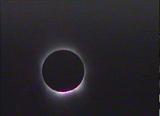
18:12:55 UTC
|
|
Finally, just after 18:13 UTC the exit diamond ring appeared. Various people
before the eclipse had predicted a long exit and we weren't disappointed.
The diamond ring lasted for several seconds before it broke into multiple
beads. Totality was over and the light level began to climb. Shadow bands
were seen again and they were as spectacular as the entry bands but did not
seem to last quite as long.
|
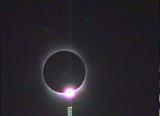
18:13:02 UTC
|
|



